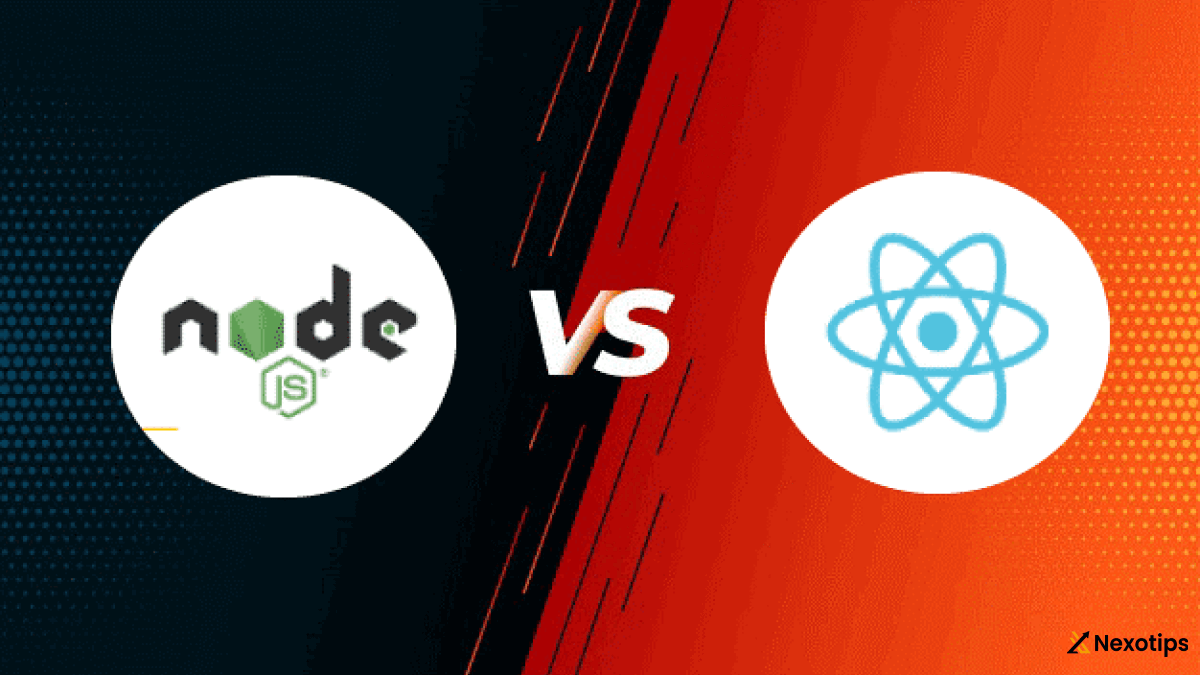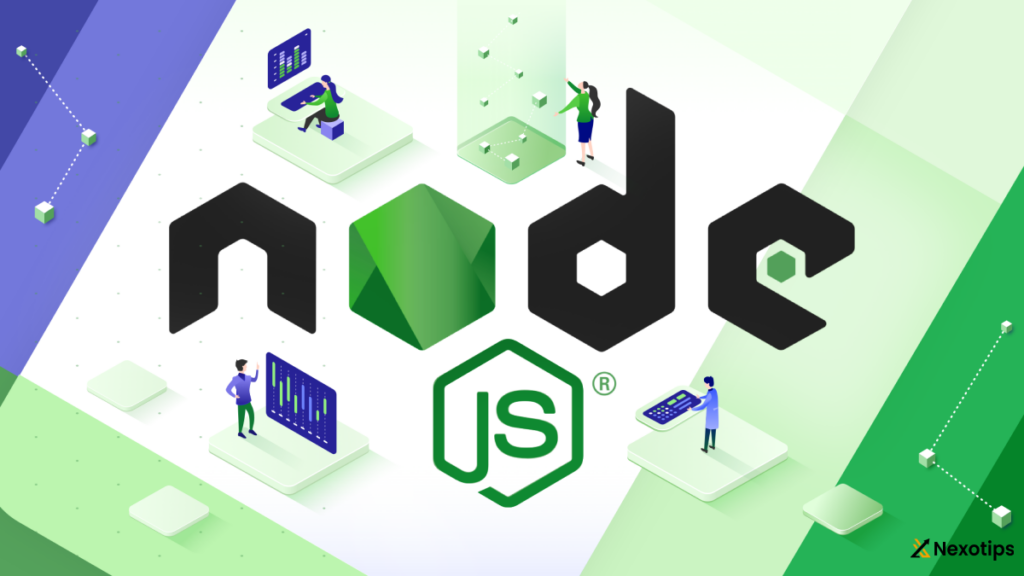
React.js vs Node.js : A Comprehensive Comparison and Interview Question-Answer for 2024
Contents
- Brief overview of React.js and Node.js
- Mention the popularity and significance of both frameworks.
- Introduce the purpose of the blog post: to compare, analyze, and provide insights into choosing between React.js and Node.js, focusing on ease of learning and interview preparation.
Understanding React.js :
React.js, commonly known as React, is an open-source JavaScript library developed by the Facebook for building user interfaces, particularly for single-page applications (SPAs) and dynamic web applications. React.js was first released in 2013 and has since gained widespread adoption in the web development community due to its simplicity, efficiency, and flexibility.
React.js, often referred to as React, is an open-source JavaScript library developed by Facebook for building user interfaces, particularly for single-page applications (SPAs). Key aspects of React.js include:
- Component-Based Architecture: React.js follows a component-based architecture, where UIs are broken down into reusable components. This approach promotes code reusability, maintainability, and scalability.
- Virtual DOM: React.js utilizes a Virtual DOM (Document Object Model) to efficiently update the UI. Instead of directly manipulating the browser’s DOM, React creates a virtual representation of the DOM in memory, allowing it to perform efficient updates and minimize DOM manipulation.
- JSX Syntax: JSX (JavaScript XML) is a syntax extension for JavaScript that allows developers to write HTML-like code within JavaScript. JSX makes it easier to create React elements and express UI components in a more declarative manner.
- Popular Projects: React.js is widely used by companies such as Facebook, Instagram, Airbnb, Netflix, and many others. It has a strong ecosystem of libraries and tools, including React Router for the routing, Redux for the state management, and Next.js for server-side rendering.

- Overview of React.js : it is origins, purpose, and main features.
- Discuss the component-based architecture of React.js.
- Explain the Virtual DOM concept and how React.js utilizes it for efficient rendering.
- Detail the JSX syntax used in the React.js for combining JavaScript with the HTML.
- Mention notable companies and projects using React.js.
React.js, commonly known as React, is an open-source JavaScript library developed by the Facebook for the building user interfaces, particularly for the single-page applications (SPAs) and dynamic web applications. React.js was first released in 2013 and has since gained widespread adoption in the web development community due to its simplicity, efficiency, and flexibility.
Key features and concepts of React.js include:
- Component-Based Architecture: React.js follows a component-based architecture, where UIs are broken down into reusable components. Each component encapsulates its logic, markup, and styling, making it easier to manage and maintain complex user interfaces.
- Virtual DOM: React.js utilizes a Virtual DOM (Document Object Model) to efficiently update the UI. Instead of directly manipulating the browser’s DOM, React creates a virtual representation of the DOM in memory. When changes occur, React calculates the minimal set of updates needed and performs them efficiently, resulting in improved performance and rendering speed.
- JSX Syntax: JSX (JavaScript XML) is a syntax extension for JavaScript that allows developers to write HTML-like code within JavaScript. JSX makes it easier to create React elements and express UI components in a more declarative manner. JSX is not mandatory for using React, but it is a popular choice for its readability and ease of use.
- Unidirectional Data Flow: React follows a unidirectional data flow model, where data flows from parent components to child components via props. This ensures predictable data flow and makes it easier to reason about the state of the application.
- Reconciliation: React.js efficiently reconciles changes to the UI by comparing the virtual DOM with the previous state and determining the minimal set of updates needed. This process, known as reconciliation, helps optimize performance and minimize unnecessary DOM manipulations.
- State Management: React components can have local state managed using the
setStatemethod. State allows components to store and manage data that can change over time. By updating the state, React components trigger re-renders, ensuring that the UI reflects the latest state of the application. - Component Lifecycle Methods: React components have lifecycle methods such as
componentDidMount,componentDidUpdate, andcomponentWillUnmount, which are invoked at the different stages of a component’s lifecycle. These methods allow developers to perform initialization, updates, and cleanup tasks. - Virtual DOM Diffing: React.js efficiently updates the DOM by performing a process known as virtual DOM diffing. When a component’s state or props change, React calculates the difference between the new virtual DOM and the previous one, and then applies the necessary updates to the actual DOM. This approach minimizes DOM manipulations and improves performance.
Understanding Node.js :
Node.js is a runtime environment built on the V8 JavaScript engine, allowing developers to run JavaScript code outside the browser. Key aspects of Node.js include:
- Event-Driven, Non-Blocking I/O: Node.js utilizes an event-driven, non-blocking I/O model, making it well-suited for building scalable and performant applications. This architecture allows Node.js to handle large numbers of concurrent connections efficiently.
- V8 Engine and Event Loop: Node.js leverages the V8 JavaScript engine, developed by Google, for executing JavaScript code. The event loop is a fundamental part of Node.js that handles asynchronous operations, ensuring that I/O operations do not block the execution of other code.
- npm Ecosystem: Node.js comes with npm (Node Package Manager), one of the largest ecosystems of open-source libraries and modules. npm allows developers to easily install, manage, and share packages, making it straightforward to integrate third-party libraries into the Node.js applications.
- Popular Frameworks: Express.js is one of the most popular frameworks built on top of Node.js, providing a minimalist web application framework for the building APIs and web servers. Other frameworks like Nest.js, Koa.js, and Sails.js offer additional features and abstractions for building Node.js applications.

- Overview of Node.js : its background, purpose, and key characteristics.
- Discuss the event-driven, non-blocking I/O model of Node.js.
- Explain the role of V8 engine and event loop in Node.js runtime environment.
- Detail the npm (Node Package Manager) ecosystem and its significance.
- Mention popular frameworks built on top of Node.js (Express.js, Nest.js, etc.).
Node.js is an open-source, cross-platform JavaScript runtime environment that allows developers to run JavaScript code outside of a web browser. It is built on Chrome’s V8 JavaScript engine and provides an event-driven, non-blocking I/O model, making it lightweight and efficient for the building scalable network applications.
Key features and characteristics of Node.js include:
- Asynchronous and Event-Driven: Node.js uses an event-driven architecture, which allows it to handle multiple concurrent connections without blocking the execution of other tasks. Asynchronous I/O operations ensure that the server can respond to requests quickly and efficiently.
- Single-threaded, Non-blocking: Node.js operates on a single-threaded event loop, which means it can handle multiple concurrent connections without the need for multi-threading. This architecture makes it lightweight and efficient, particularly for I/O-intensive applications.
- NPM (Node Package Manager): Node.js comes with npm, the largest ecosystem of open-source libraries and packages for JavaScript. npm allows developers to easily install, manage, and share reusable code modules, making it convenient for building complex applications.
- Cross-Platform: Node.js is cross-platform, meaning it can run on various operating systems, including Windows, macOS, and Linux. This makes it suitable for developing applications that can run on different environments without modification.
- Scalability: Node.js is highly scalable, making it suitable for building real-time, data-intensive applications such as chat applications, streaming services, and gaming platforms. Its event-driven architecture allows it to handle thousands of concurrent connections with minimal resource consumption.
- Community Support: Node.js has a vibrant and active community of developers who contribute to its ongoing development and maintenance. The community provides support, documentation, and a wide range of third-party modules and libraries to extend the functionality of Node.js.
- Use Cases: Node.js is commonly used for building web servers, API servers, microservices, real-time applications, IoT (Internet of Things) applications, and serverless functions. Its flexibility and performance make it suitable for a wide range of use cases.
Comparing Learning Ease :
When comparing the learning ease of the React.js and Node.js, it is essential to consider factors such as :
- JavaScript Proficiency: React.js primarily requires proficiency in the JavaScript and familiarity with the concepts like functions, objects, and arrays. Developers with prior experience in the JavaScript find it relatively easy to learn React.js, especially with its component-based architecture and JSX syntax.
- Asynchronous Programming: Node.js, on the other hand, introduces concepts of asynchronous programming, callbacks, promises, and async/await. While these concepts may initially be challenging for developers new to the JavaScript, they are essential for the building scalable and non-blocking applications with Node.js.
- Learning Resources: Both React.js and Node.js have extensive documentation, tutorials, and online courses available for the learning. React.js benefits from a large community and ecosystem of resources, including official documentation, React tutorials, and courses on platforms like Udemy and Pluralsight. Similarly, Node.js has comprehensive documentation, npm packages, and online courses covering various aspects of Node.js development.
- Analyze the learning curve of React.js, highlighting its simplicity for the developers familiar with JavaScript and HTML.
- Discuss the availability of extensive learning resources such as documentation, tutorials, and online courses for React.js.
- Evaluate the learning curve of Node.js, emphasizing its asynchronous programming model and server-side concepts.
- Discuss the abundance of resources, including documentation, libraries, and frameworks for learning Node.js.
Strengths and Use Cases :
Understanding the strengths and ideal use cases for the React.js vs Node.js helps developers choose the right technology for their projects:
- React.js Strengths:
- Efficient Rendering: React’s Virtual DOM and efficient rendering algorithms optimize UI performance.
- Reusable Components: React’s component-based architecture promotes code reusability and modularity.
- Strong Community Support: React has a large and active community, with frequent updates, libraries, and tools available.
- Ideal Use Cases: React.js is well-suited for building dynamic user interfaces, SPAs, progressive web apps (PWAs), and mobile applications using frameworks like React Native.
- Node.js Strengths:
- Scalability and Performance: Node.js’ event-driven, non-blocking architecture enables high scalability and performance for server-side applications.
- JavaScript Everywhere: With Node.js, developers can use JavaScript for both frontend and backend development, allowing for code sharing and full-stack JavaScript development.
- Extensive Ecosystem: Node.js has a vast ecosystem of npm packages, frameworks, and tools for building a wide range of applications, including web servers, APIs, real-time applications, and microservices.
- Ideal Use Cases: Node.js is suitable for building APIs, web servers, real-time applications, streaming services, and microservices architectures.
- Highlight the strengths and advantages of React.js, such as its efficient rendering, reusable components, and strong community support.
- Provide examples of use cases where React.js excels, such as building dynamic user interfaces for single-page applications (SPAs).
- Discuss the strengths of Node.js, including its scalability, performance, and suitability for building real-time applications and APIs.
- Provide examples of popular applications and services powered by Node.js.
Interview Questions for React.js :
Preparing for a React.js interview involves understanding key concepts and commonly asked questions. Here are some interview questions and answers for React.js:
- What is React.js, and what are its main features?
- Answer: React.js is a JavaScript library for building user interfaces. Its main features include a component-based architecture, Virtual DOM, JSX syntax, and unidirectional data flow.
- What is JSX, and why is it used in React.js?
- Answer: JSX (JavaScript XML) is a syntax extension for JavaScript that allows developers to write HTML-like code within JavaScript. It is used in React.js to create React elements and express UI components in a more declarative manner.
- Explain the component lifecycle methods in React.js.
- Answer: React components have lifecycle methods such as componentDidMount, componentDidUpdate, and componentWillUnmount, which are invoked at different stages of a component’s lifecycle. These methods allow developers to perform initialization, updates, and cleanup tasks.
- What is the difference between state and props in React.js?
- Answer: State is an internal data storage mechanism used for managing component-specific data, while props (short for properties) are external data passed to a component from its parent. State is mutable and controlled by the component itself, while props are immutable and passed down from parent components.
- How does React handle data flow and state management?
- Answer: React follows a unidirectional data flow model, where data flows from parent components to child components via props. React components can have local state managed using the setState method, allowing them to re-render when the state changes.
Interview Questions for Node.js :
Preparing for a Node.js interview involves understanding asynchronous programming, event-driven architecture, and common Node.js concepts. Here are some interview questions and answers for Node.js:
- What is Node.js, and what are its main features?
- Answer: Node.js is a JavaScript runtime built on the V8 JavaScript engine, allowing developers to run JavaScript code outside the browser. Its main features include an event-driven, non-blocking I/O model, npm ecosystem, and scalability.
- Explain asynchronous programming in Node.js.
- Answer: Asynchronous programming in the Node.js allows non-blocking execution of I/O operations, enabling high concurrency and scalability. It uses callbacks, promises, and async/await syntax for handling asynchronous code.
- How does Node.js handle concurrency and scalability?
- Answer: Node.js utilizes an event-driven

React.js vs Node.js :
| Node.js | React.js |
|---|---|
| Node.js used as a back-end framework | React is used for developing user interfaces. |
| It supports the Model–view–controller (MVC) framework. | Does not support the Model–view–controller (MVC) framework. |
| It runs on chrome’s v8 engine and uses an event-driven, non-blocking I/O model, which is written in C++. | It uses Node.js to compile and optimize the JavaScript code and easy to create UI Test cases. |
| Node.js handles requests and authentication from the browser, make database calls, etc. | It makes API calls and processes in-browser data. |
| Here the Real-time data streaming is handled easily. | In React complex architecture makes it hard to keep track of the traditional approach. |
| Framework for JavaScript execution having the largest ecosystem of open source libraries. | Facebook-backed Open Source JS library. |
| The language used is only JavaScript. | The language used is JSX and JavaScript. |
| There is no DOM (Document Object Model) concept that is Used. | Here the Virtual DOM (Document Object Model) is Used that makes it faster. |
| It is easy to write microservices in Node.Js | Microservices are difficult to be written in React.Js |
| It is highly scalable. | Scalability is still a challenge. |
| It has a simple architecture. | It has a complex architecture. |
End:
Sum up the central issues talked about in the blog entry.
Repeat the significance of grasping the distinctions among React.js vs Node.js for the designers and occupation searchers.
Empower further investigation and figuring out how to the dominate these fundamental advances.
Shutting Comments:
Thank the perusers for the drawing in with the substance.
Welcome them to share their considerations, encounters, and any extra inquiries they might have.
Give connects to the pertinent assets and further perusing materials for nonstop learning for React.js vs Node.js.
